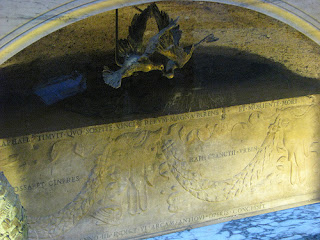The Capitoline Wolf is a bronze statue realised by the Etruscans in the V century B.C. During the XV century the twins, made by Pollaiolo, have been added. This wolf is the symbol of the city of Rome and of its birth because, according to the legend, the vestal virgin Rea Silvia was raped by Mars, the god of war, and gave birth to two twins. Few days later, the grandfather of the twins, Numitore was dismissed by his brother Amulio as king of Alba Longa, a city not far from where Rome would be eventually born. So Amulio, who wanted to avoid the two nephews of Numitore, once grown up, could have taken a revenge, he decided to put them in a basket and throw them in the Tiber. The basket stopped at the beginning of a small hill and it was found by a wolf who suckled them. Eventually the twins were found by a shepherd called Faustolo. Traditionally the twins, Romolo and Remo, are the founders of Rome and thanks to the wolf they survived. This is why the wolf is the symbol of Rome.

















































